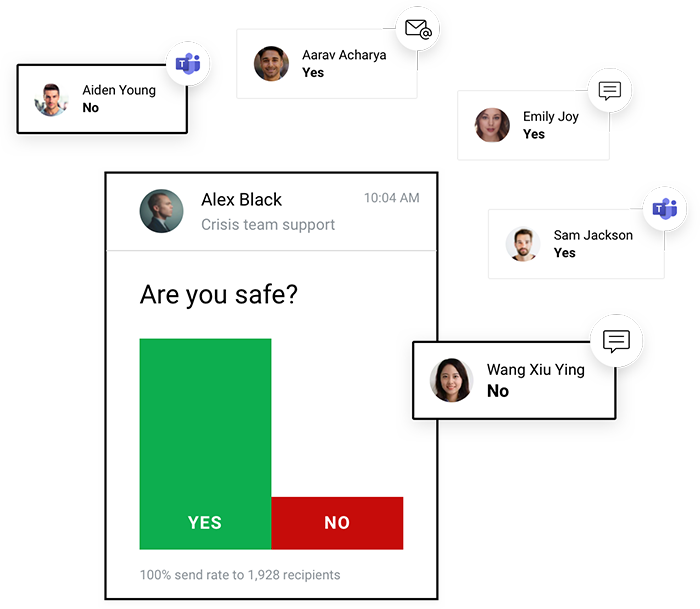As organisations worldwide grapple with the ongoing COVID-19 pandemic, localised threats from protests to severe weather continue to challenge security and safety professionals to keep employees safe whether they are working from home or onsite.
Whilst organisations may consider adopting an emergency notification system to improve stakeholder communication, ongoing costs and budget pressures are often significant barriers to acquiring a system.
Fortunately, with the Australian Government release of the Protective Security Framework (PSPF), security and safety professionals can now justify the adoption of an emergency notification system to protect people and assets, thus complying with the physical security outcome of the PSPF.
How can emergency notifications help organisations comply with PSPF?
Organisations are required to implement physical security measures that minimise or remove the risk of harm to people, as well as information and physical asset resources being made inoperable or inaccessible, or being accessed, used or removed without appropriate authorisation.
Emergency notification systems – designed for rapid communication and maximum reach – can automatically send alerts and messages via multiple communication channels. These systems typically allow for two-way messages, SMS polls to triage people in need of support and emergency broadcasts to a mass audience.
Emergency notification systems can also be used to activate an incident response team, allowing the organisation to get ahead of the situation before it escalates and causes harm. Additionally, emergency notification systems integrated with threat intelligence for early warning could enhance your digital toolset and further protect people and assets.
What to look for in an emergency notification system
1. A simple user interface
During an incident such as a lockdown, the last thing you need is a clunky design stalling your ability to quickly action communications. The situation simply won’t afford it. A simple user interface is absolutely critical to empower your team to take action within a few OBVIOUS clicks.
This empowers the team to confidently compose and broadcast new messages with speed. Having access to pre-scripted message templates within the tool and as part of your natural workflow, will further reduce the time it takes to send.
2. Real time analytics: Triaging to focus
In an organisation of 10,000 staff, during a critical event, you may only be concerned about the 40 that are in danger, within a certain location. By having real time analytics in your mass notifications panel, you will be able to triage your stakeholders of most concern immediately.
This could include send, pending and failed messages, as well as polling responses to welfare check or location request messages.

3. Ensuring data integrity: API connection to your active directory
Data integrity is paramount to ensure messages are being successfully delivered. Afterall, you want to ensure the 5,000 messages you’ve just sent have gone to people with active or correct contact details.
An emergency notification system allowing for integration with your corporate directory or contact database will ensure the contact list within the platform remains up-to-date in real time.
4. Navigating telco traffic jams: Leveraging a gateway provider
In the age of mobile marketing, the telecommunications airways are busy. When sending 10,000 messages to stakeholders, it’s important to ensure your message is not held up by telecommunication providers due to traffic jams or network congestion. You can mitigate potential telco traffic jams by adopting an emergency notification system that leverages a gateway provider.
These providers have access to multiple telco networks, ensuring your message is successfully delivered. If in doubt, you could ask for an SMS speed test as part of your product demo.
5. Integration into a critical event management system
To support your physical security outcome, you may be asked to provide evidence of actions and tasks undertaken to protect your people and assets during an event.
You can confidently do so by ensuring the emergency notification system you adopt is fully integrated into a critical event management system, providing you with a single operating picture of all conversations, messages and poll results – timestamped against all outbound and inbound messages.
Integrating emergency notifications with an early warning system
As outlined in PSPF, the first principal “Security is everyone’s responsibility” promotes that “fostering a positive security culture is critical to security outcomes”.
Engaging workers outside of the security and safety sphere about security can be challenging. Traditional approaches such as online learning can fall short of creating true engagement and security ownership.
To create awareness and subsequently engagement, many organisations are leveraging early warning threat systems to contextualise local threats and alert employees, on a more continuous basis. By establishing automated alerts, with quick step actions to assess conditions and report of material threats, organisations can build ownership of threat management throughout various management layers.
Through automated alert notification, Security professionals can bring critical information such as damaging winds, hazardous fires, plummeting air quality or severe flooding to management, ahead of a potential impact to their sites.
As time is of the essence in any disaster, this forewarning enables security professionals to proactively protect people and infrastructure, whilst increasing the level of engagement across the organisation of security issues.
Adopting emergency notification systems are often constrained by ongoing costs and budget pressure. By leveraging PSPF, security and safety professionals can now justify investing in new digital toolsets to help them protect people and assets. For a fully integrated solution, check out iluminr and get started for free today.
Emergency Notifications
From welfare checks to emergency mass notifications, instantly connect with people via multiple channels to keep them safe and out of harm’s way.
- Rapidly broadcast two-way messaging via SMS and Email
- Quickly send a poll to triage those in need of support
- Easily compose and send a new message from anywhere in the platform
- Immediately see delivery status updates and recipient responses


Threat Intelligence and Early Warning
Proactively protect people and business assets from nearby weather threats with live data feeds and automated alert notifications.
- View sites potentially impacted by severe weather threats
- Flexible settings to filter out clutter and only see threats that matter to you
- 24/7 situational awareness to ensure you stay ahead of impending threats
- Automate alert notifications to relevant stakeholders when a threat is identified
Centralised event information
A fully integrated emergency response system creating a single operating picture to increase efficiency and collaboration.
- Collaborate with key stakeholders
- Access live issues, task and assumption boards
- Build and share event reports with stakeholders
- Access event information on any device, wherever you are

As organisations worldwide grapple with the ongoing COVID-19 pandemic, localised threats from protests to severe weather continue to challenge security and safety professionals to keep employees safe whether they are working from home or onsite.
Whilst organisations may consider adopting an emergency notification system to improve stakeholder communication, ongoing costs and budget pressures are often significant barriers to acquiring a system.
Fortunately, with the Australian Government release of the Protective Security Framework (PSPF), security and safety professionals can now justify the adoption of an emergency notification system to protect people and assets, thus complying with the physical security outcome of the PSPF.
How can emergency notifications help organisations comply with PSPF?
Organisations are required to implement physical security measures that minimise or remove the risk of harm to people, as well as information and physical asset resources being made inoperable or inaccessible, or being accessed, used or removed without appropriate authorisation.
Emergency notification systems – designed for rapid communication and maximum reach – can automatically send alerts and messages via multiple communication channels. These systems typically allow for two-way messages, SMS polls to triage people in need of support and emergency broadcasts to a mass audience.
Emergency notification systems can also be used to activate an incident response team, allowing the organisation to get ahead of the situation before it escalates and causes harm. Additionally, emergency notification systems integrated with threat intelligence for early warning could enhance your digital toolset and further protect people and assets.
What to look for in an emergency notification system
1. A simple user interface
During an incident such as a lockdown, the last thing you need is a clunky design stalling your ability to quickly action communications. The situation simply won’t afford it. A simple user interface is absolutely critical to empower your team to take action within a few OBVIOUS clicks.
This empowers the team to confidently compose and broadcast new messages with speed. Having access to pre-scripted message templates within the tool and as part of your natural workflow, will further reduce the time it takes to send.
2. Real time analytics: Triaging to focus
In an organisation of 10,000 staff, during a critical event, you may only be concerned about the 40 that are in danger, within a certain location. By having real time analytics in your mass notifications panel, you will be able to triage your stakeholders of most concern immediately.
This could include send, pending and failed messages, as well as polling responses to welfare check or location request messages.

3. Ensuring data integrity: API connection to your active directory
Data integrity is paramount to ensure messages are being successfully delivered. Afterall, you want to ensure the 5,000 messages you’ve just sent have gone to people with active or correct contact details.
An emergency notification system allowing for integration with your corporate directory or contact database will ensure the contact list within the platform remains up-to-date in real time.
4. Navigating telco traffic jams: Leveraging a gateway provider
In the age of mobile marketing, the telecommunications airways are busy. When sending 10,000 messages to stakeholders, it’s important to ensure your message is not held up by telecommunication providers due to traffic jams or network congestion. You can mitigate potential telco traffic jams by adopting an emergency notification system that leverages a gateway provider.
These providers have access to multiple telco networks, ensuring your message is successfully delivered. If in doubt, you could ask for an SMS speed test as part of your product demo.
5. Integration into a critical event management system
To support your physical security outcome, you may be asked to provide evidence of actions and tasks undertaken to protect your people and assets during an event.
You can confidently do so by ensuring the emergency notification system you adopt is fully integrated into a critical event management system, providing you with a single operating picture of all conversations, messages and poll results – timestamped against all outbound and inbound messages.
Integrating emergency notifications with an early warning system
As outlined in PSPF, the first principal “Security is everyone’s responsibility” promotes that “fostering a positive security culture is critical to security outcomes”.
Engaging workers outside of the security and safety sphere about security can be challenging. Traditional approaches such as online learning can fall short of creating true engagement and security ownership.
To create awareness and subsequently engagement, many organisations are leveraging early warning threat systems to contextualise local threats and alert employees, on a more continuous basis. By establishing automated alerts, with quick step actions to assess conditions and report of material threats, organisations can build ownership of threat management throughout various management layers.
Through automated alert notification, Security professionals can bring critical information such as damaging winds, hazardous fires, plummeting air quality or severe flooding to management, ahead of a potential impact to their sites.
As time is of the essence in any disaster, this forewarning enables security professionals to proactively protect people and infrastructure, whilst increasing the level of engagement across the organisation of security issues.
Adopting emergency notification systems are often constrained by ongoing costs and budget pressure. By leveraging PSPF, security and safety professionals can now justify investing in new digital toolsets to help them protect people and assets. For a fully integrated solution, check out iluminr and get started for free today.
Emergency Notifications

From welfare checks to emergency mass notifications, instantly connect with people via multiple channels to keep them safe and out of harm’s way.
- Rapidly broadcast two-way messaging via SMS and Email
- Quickly send a poll to triage those in need of support
- Easily compose and send a new message from anywhere in the platform
- Immediately see delivery status updates and recipient responses
Threat Intelligence and Early Warning

Proactively protect people and business assets from nearby weather threats with live data feeds and automated alert notifications.
- View sites potentially impacted by severe weather threats
- Flexible settings to filter out clutter and only see threats that matter to you
- 24/7 situational awareness to ensure you stay ahead of impending threats
- Automate alert notifications to relevant stakeholders when a threat is identified
Centralised event information

A fully integrated emergency response system creating a single operating picture to increase efficiency and collaboration.
- Collaborate with key stakeholders
- Access live issues, task and assumption boards
- Build and share event reports with stakeholders
- Access event information on any device, wherever you are















